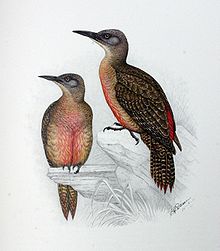Ground woodpecker
| Ground woodpecker | |
|---|---|

| |
| In South Africa | |
| Scientific classification | |
| Kingdom: | |
| Phylum: | |
| Class: | |
| Order: | |
| Family: | |
| Subfamily: | |
| Genus: | Geocolaptes Swainson, 1832
|
| Species: | G. olivaceus
|
| Binomial name | |
| Geocolaptes olivaceus (Gmelin, 1788)
| |
The ground woodpecker (Geocolaptes olivaceus) is one of only three ground-dwelling woodpeckers in the world (the others are the Andean and Campo flickers). It inhabits rather barren, steep, boulder-strewn slopes in relatively cool hilly and mountainous areas of South Africa, Lesotho and Swaziland and has yet to be recorded outside of Southern Africa. It is found in a broad swath running from south-west to north-east, from the Cape Peninsula and Namaqualand to Mpumalanga.[1]
Description
The ground woodpecker is the largest woodpecker in the region, reaching 30 cm in length. The upper parts are greyish-brown with pale spotting, and the rump is red, more visible in flight. The upper sides of wings and tail are brown barred with white. The underparts are buff, flushed with pink or red. The underside of the tail is pale brown, barred with paler colour. The beak is black, long and slender, the irises pink or yellow, and the legs grey. Males and females are broadly similar, but the female has slightly less red and pink than the male. The juvenile is similar to the female.[2]
Ecology
It usually lives in pairs or small parties and is best located by its loud, raucous 2-note call (chik-ree, chik-ree) with head-swinging. It often peers over or around rocks at intruders.[2]
The diet of the ground woodpecker consists mainly of ants with their larvae, pupae and eggs. These are extracted from dead wood or between rocks, using its long, sticky tongue. It also feeds on the ground, flicking awaydead leaves in a manner reminiscent of flickers. Unusually for a woodpecker, one bird does sentry duty from a high point, looking for aerial predators, and this bird is relieved every ten minutes or so by another member of the group.[2]
It breeds in spring and early summer (August to November), nesting is in a tunnel excavated in the vertical bank of a stream or watercourse. Usually 3 glossy white eggs are laid in a chamber at the end of the tunnel.[2]

References
- ^ a b Template:IUCN
- ^ a b c d Gerard Gorman (2014). Woodpeckers of the World: The Complete Guide. A&C Black. pp. 190–191. ISBN 978-1-4081-4717-7.
- Roberts' Birds of Southern Africa – 6th edition (John Voelcker Fund, 1993) ISBN 0-620-17583-4
External links
- Ground Woodpecker – Species text in The Atlas of Southern African Birds.
- Picidae – Nashville Zoo

